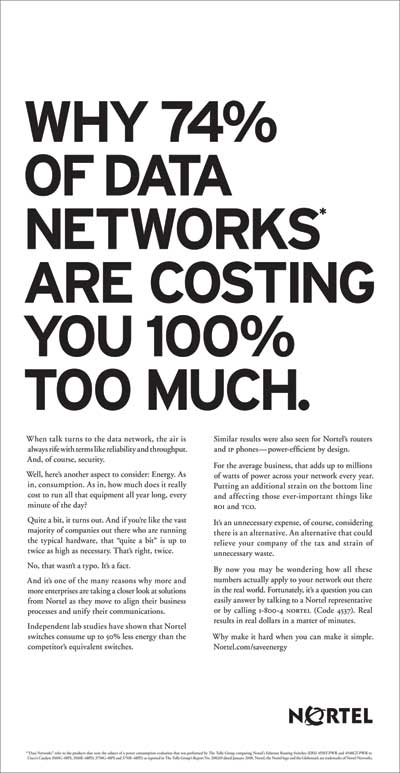GOLD WINNER: Nortel — How much is your network costing you?

Client: Nortel
Entrant Company: McCann Worldgroup (Universal McCann Media Company)
Entry Category: A Local Execution of a Multinational Campaign
Names to be credited with submission:
• Lauren Flaherty, Nortel
• Peter Finter, Nortel
• Anna Griffin, Nortel
• Mirko Mueller-Goolsbey, Nortel
•
Matt Ross, McCann Worldgroup
•
Jeff Thomas, McCann Worldgroup
•
John McNeil, McCann Worldgroup
•
Kurtis Glade, McCann Worldgroup
•
Fiona Meier, McCann Worldgroup
Time Period of Campaign: 2008
Case Study Summary:
Marketing Situation:Over the past five years, one brand has run away with the enterprise networking category. Cisco has built a legacy of data infrastructure systems requiring customers to update not only the core, but also the periphery, creating a huge advantage and lead for Cisco when it comes to share of wallet with each customer.
Nortel is certainly a David to this Goliath-- with a 4% market share and with just a 2% share of voice in the category’s spend.
The goal was to find unique differentiators to expose the weakness of a competitor while providing a true comparison to Nortel’s products and solutions. In early 2008, Nortel decided it needed to find a way to get out of the giant’s shadow and take on Cisco directly, getting the same prospects to consider both brands side by side.
Key Insights:The insight was brought to us by a customer. In a sales meeting, an existing customer acknowledged not only his satisfaction with the performance of Nortel products, but also his positive surprise that since running on Nortel, his energy bill had dropped significantly. Nortel’s heritage in carrier products and solutions meant Nortel has always built for energy efficiency― a critical requirement for those high-volume users of data switches and routers. Nortel went back into the labs and conducted tests against Cisco’s comparable products to confirm their energy efficiency. Then independent research validated the tests and documented energy savings of up to 40% vs. Cisco. Bingo! A “forgotten” advantage became a true differentiator in the enterprise market.
Thus, the Cisco Energy “Tax” was born: the price you pay for going with the leader in the market; the price you pay for not doing your homework. Our differentiation was fact-driven and our target fact-hungry, so we developed executions that allowed people to investigate and discover the truth themselves in lieu of just telling them all about it.
 Media Strategy: The next step involved spreading the word of Nortel’s product advantage beyond tradeshow attendees to a broader audience. The objective was to drive key IT staff to determine the potential cost savings for their organization using Nortel instead of Cisco. This was achieved via the use of an energy-efficiency calculator that was designed to provide customized facts to be shared within the organization and to support the business case for Nortel’s products. Media Strategy: The next step involved spreading the word of Nortel’s product advantage beyond tradeshow attendees to a broader audience. The objective was to drive key IT staff to determine the potential cost savings for their organization using Nortel instead of Cisco. This was achieved via the use of an energy-efficiency calculator that was designed to provide customized facts to be shared within the organization and to support the business case for Nortel’s products.
NEWSPAPER: We used provocative headlines (“Why 74% of data networks are costing you 100% too much.”) to grab the attention of our target, and then leveraged a print buy to drive targets online to get the facts. However, instead of the traditional dot-com destination, we asked people to go to a search engine and query the term “Cisco Energy Tax,” an engagement designed, again, to feel more like fact-finding than messaging.
ONLINE: We created banners that drove to the Nortel Energy Efficiency Calculator, an online tool where CIOs and their IT staff could plug in their own data and see what kind of Cisco Energy Tax their own organization was paying.
VIDEO and TV: Having confirmed that the message resonated with the target, we expanded our investment to include video and cable TV to continue to provoke the target and ask them “What is your network costing you?”
How Could this be a Template for Other Campaigns or for World Class Standards?
Whereas ways to execute (message, media) might slightly differ from market to market, the strategic fundamentals remain the same: know your audience’s priorities (in this case, cost reduction) as well as their media consumption habit (searching online), know the market condition (in this case, rising energy costs).
Then, create messages and use channels that deliver fact-based marketing in a relevant way that can easily be leveraged in other media to maximize the paid investment. Finally, continue to provide data and tools to allow targets around the world to get the facts and to tell others.
Results: Nortel’s objectives were exceeded in terms of being noticed with paid and unpaid media, and of growing the sales pipeline.
Nortel’s sales force reported immediate success using the online calculator with prospects, calling it “the best tool we’ve ever had to wedge in the door against Cisco.” Within weeks of launching the campaign, Nortel’s enterprise president, Joel Hackney, reported as many as 50 enterprise sales attributed to the Cisco Energy Tax campaign.
In one extreme example, a $2M Cisco sales order from a school district was pulled and given to Nortel after the decision makers calculated their savings with Nortel.
The Cisco Energy Tax story was repeated and linked to in major industry blogs such as TechRepublic, ZDnet and Network World, successfully extending the reach of the campaign beyond the limits of paid media. The traditional press also picked up the story, including the National Post and the Wall Street Journal, which featured front page coverage in the Marketplace section on June 16, 2008.
And finally, the campaign resulted in an incredible double-digit growth in the sales pipeline, more than three times the stated goals for growth.
|